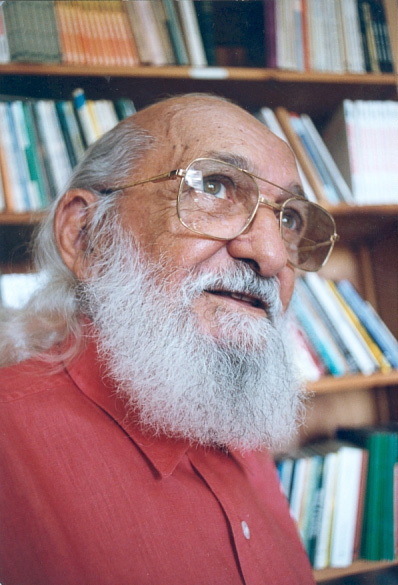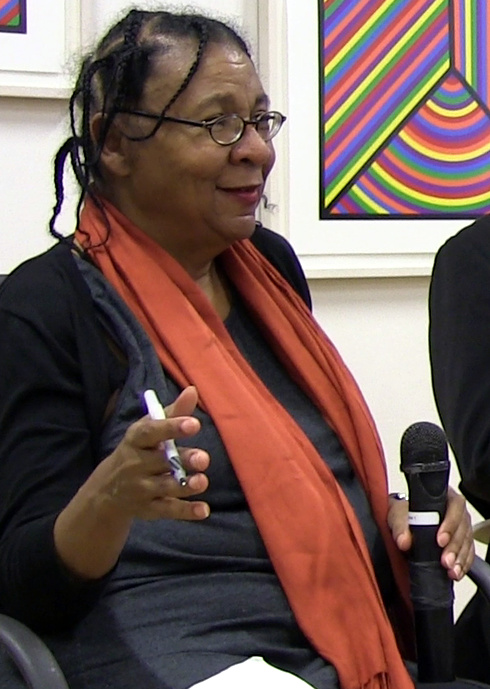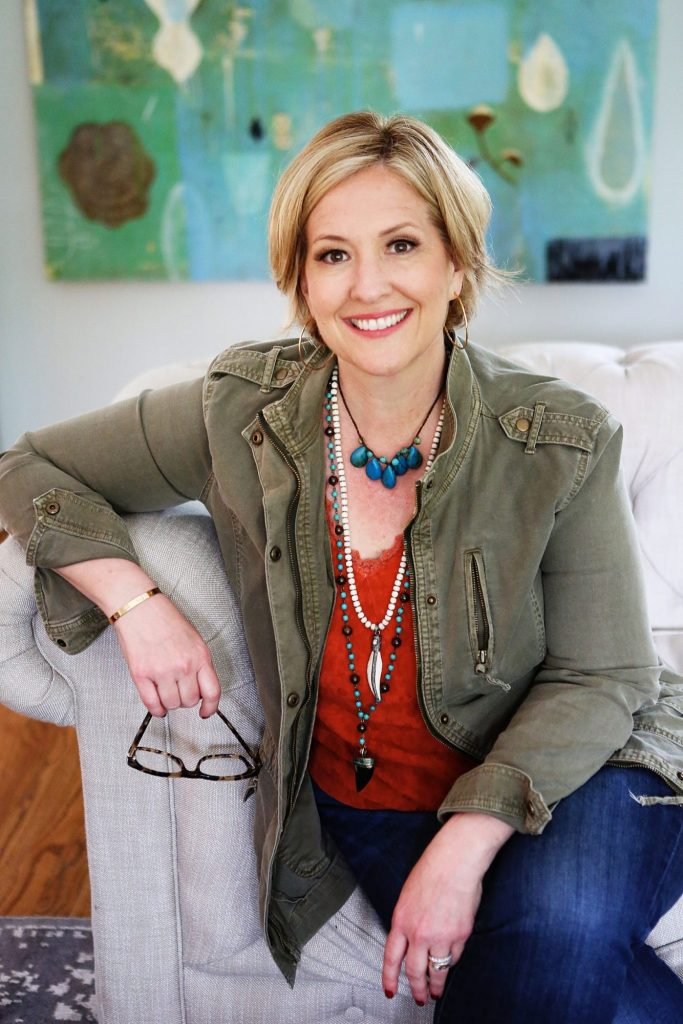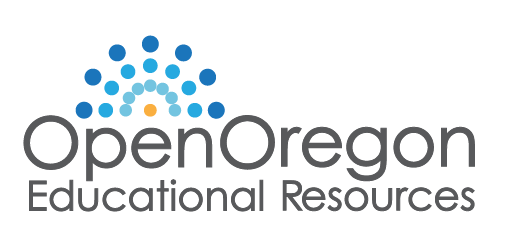7.6 Education and Liberation
Government response isn’t the only way that education can create social change, or that education in response to wider social forces. Teachers, students, and communities can also create social change.
7.6.1 Pedagogy of the Oppressed and Emerging Applications

Figure 7.20. Brazilian activist and educator, Paolo Friere
As we continue to explore theories about education, we have many useful lenses. Education serves a useful function, supporting people in learning, and participating with more choices in their societies. Education can also be a way for people in power to maintain their power, because schools themselves can be institutions of social control. By using segregation or tracking, the institution reinforces social patterns of structural racism, sexism, homophobia, and other discriminatory practices. As a third option, education can also serve the purpose of liberation and healing. To explore this approach we turn to Paulo Friere, bell hooks, Brené Brown, and the educators and activists of the Open Oregon Project.
Paulo Friere, figure 7.20, was a sociologist, activist and educator in Brazil and internationally from 1940 to his death in 1997. He founded and ran adult literacy programs in the slums of northeast Brazil. When he taught reading and writing, he used everyday words and concepts that his students needed to know for living well, like terms for cooking, childcare or construction. More revolutionary, though, was his idea that education could also be a force for liberation.
He believed and practiced that students and teachers could ask questions together about why things were the way they were in society. By arguing that the teacher was also a learner and that students were also teachers, he created classrooms in which students could feed their own curiosity and come to their own conclusions. Friere explores the practice of pedagogy, the art, science, or profession of teaching
His most famous book is Pedagogy of the Oppressed. In it, he condemns the banking model of education, which he defines as “the concept of education in which knowledge is a gift bestowed by those who consider themselves knowledgeable upon those whom they consider to know nothing”. (Friere n.d). He argues that the banking model of knowledge is the most common but least useful form of education. He writes,
Education thus becomes an act of depositing, in which the students are the depositories and the teacher is the depositor. Instead of communicating, the teacher issues communiques and makes deposits which the students patiently receive, memorize, and repeat. This is the “banking” concept of education, in which the scope of action allowed to the students extends only as far as receiving, filing, and storing the deposits. They do, it is true, have the opportunity to become collectors or cataloguers of the things they store. But in the last analysis, it is the people themselves who are filed away through the lack of creativity, transformation, and knowledge in this (at best) misguided system. Friere:72)
In contrast, his model of education emphasizes dialog, action and reflection. In dialog, the students and the teachers have conversations about what they are learning and how they see things working in the world. Each person contributes from their own experience and knowledge. In action. He writes, “To enter into dialogue presupposes equality amongst participants. Each must trust the others; there must be mutual respect and love (care and commitment). Each one must question what he or she knows and realize that through dialogue existing thoughts will change and new knowledge will be created.” (Friere n.d.)
This dialog is essential for learning and transformation, but it is insufficient as a social force. He argues that teaching and learning also require action and reflection. This combination of engaging in the world and then reflecting on what you learned, or praxis, is the true goal of education, creating a more equitable society by taking conscious action. He writes, “It is not enough for people to come together in dialogue in order to gain knowledge of their social reality. They must act together upon their environment in order critically to reflect upon their reality and so transform it through further action and critical reflection.” (Friere n.d)
His institute still influences educators and thinkers worldwide about how to use education to promote social justice.

Figure 7.21. Black author, educator and activist bell hooks
Author and educator bell hooks is seen in figure 7.21. She uses lower case letters for her name so people devote more focus to her works, not her personal qualities (Williams 2013). Hooks builds on the work of Paulo Friere, feminist theorists, and her own experiences to expand on this vision of the radical transformative power of education. In her book, Teaching to Transgress, she writes,
For black folks teaching—educating—was fundamentally political because it was rooted in antiracist struggle. Indeed, my all black grade schools became the location where I experienced learning as revolution.
Almost all our teachers at Booker T. Washington were black women. They were committed to nurturing intellect so that we could become scholars, thinkers, and cultural workers—black folks who used our “minds.” We learned early that our devotion to learning, to a life of the mind, was a counter-hegemonic act, a fundamental way to resist every strategy of white racist colonization. Though they did not define or articulate these practices in theoretical terms, my teachers were enacting a revolutionary pedagogy of resistance that was profoundly anticolonial. (hooks 1994:2)
In this specific instance, she argued not only that education itself can create transformation, but that a classroom with only black students specifically nurtured and educated them. By creating space outside of the dominant paradigm, Black children could learn in an environment untainted by racism.
Not only does she assert that education can be revolutionary in its approach and its outcomes, she argues that education is essentially done in community. Social transformation occurs within the context of an engaged classroom of learners. She writes, “Seeing the classroom always as a communal place enhances the likelihood of collective effort in creating and sustaining a learning community.” (hooks 1994:8). Like Friere, she argues that a classroom is a community, and that teaching and learning transform the wider world.


Figure 7.22. White researcher, author and educator Brené Brown
Similarly, Brené Brown focuses on creating brave classrooms (figure 7.22). She is a researcher, teacher, author and change maker. In her research she flips the traditional scientific model on its head, not starting with a fixed hypothesis, but starting with curiosity. In this “grounded theory” approach, grounded theory methodology, as originally developed by Glaser and Strauss she asks people to tell their stories first, and then see what insights those stories yield. She writes, “We let the participants define the problem or their main concern about the topic, we develop a theory, and then we see how and where it fits in the literature” (Brown 2012:253).
As a teacher of graduate students in Houston, Texas she used a similar approach. The students developed their own syllabus and set of readings as they were exploring issues in social work. To launch the class, they settled on a series of questions. Then the students found experts and articles that began to address their questions. Diving into the work, they discussed how to understand and apply the information to supporting their clients in creating more resilient lives. Both of these methods center the person who is being interviewed and the student who is learning.
Brown goes a step farther in seeing education as a force for healing and liberation. She writes that humans need to belong, and that classrooms are amazing places for that belonging to occur. In the quote referenced in figure 7.22, she asserts that classrooms should be places where students and teachers alike can be brave, vulnerable, creative, and healing. She echoes the work of Friere saying that universities can be a source of transformational change,
To me, revolutionary change is tumultuous and difficult and requires a brand new lens for looking at the world. I think if there is anything that universities have the opportunity to do and have done incredibly well, it’s to help people try on new ways of being, look through new lenses, and understand new perspectives. This is the place where it can really happen. It doesn’t have to be the only place where it happens, but it could be one of the central places where it happens, even in relationships between the community and the university—not just the students.” (Brown 2017: video)
Each of these scholars and activists argues that education itself, when done in a transformational way, will create change in the student, in the teacher, in the classroom and in the wider world. With this approach, we see that education itself becomes a tool for addressing social problems.

Figure 7.23. Open Oregon Educational Resources Logo
In a final example, we explore the project from which this book arose as an exercise in transformation in learning. The Open Oregon Educational Resources program is a group of educators, funded by the state of Oregon to create high quality educational resources for students (figure 7.23). Through developing both textbooks and courses that center diversity, equity and inclusion, this effort is making school more affordable to many students.
The project allows people who are normally excluded from the process of research and textbook creation to be included in the process. We are a collective of students, teachers, researchers, experienced academics, activists and artists who are weaving our stories into books and courses that reflect and explain our social life. Because we share the work, some of us contributing a lot, and others of us only a few pages, many of us are able to tell our stories.
The approach itself is revolutionary, putting the power to create and share knowledge in the hands of ordinary people. Who would have imagined this in the early days of the first printing press?
7.6.2 Decolonizing Approaches
An important development in teaching is related to the recognition that for more than a century, Indigenous students in North America have been part of a forced assimilation plan. Their heritage and knowledge was rejected and suppressed, and ignored by the education systems of the governments ruling in their homelands. A parallel recognition is that our educational systems, based on this culture of colonization, perpetuates systems of inequity.
Decolonizing approaches to teaching have been developed to respond to this reality. First, this approach intends to introduce curriculum to students that acknowledges different knowledge systems and ways of knowing. These pre-colonial ways are given priority. Decolonized education is also rooted in connections to place. Place-based education empowers students and helps restore cultural knowledge. Decolonizing education focuses on re-establishing links to the community. The idea is that education should not occur in a vacuum, and these links are essential for contextualizing knowledge, deepening understanding, encouraging community involvement, and reconnecting students with a vital support system. Finally, the decolonizing approach also intends to reflect carefully on the goal of education. This reflection often uncovers motives for mandated education deeply rooted in colonialist policy.
7.6.3 Culturally Responsive Education
Culturally responsive teaching is another valuable tool that educators are applying to better serve a diversity of students. Cultural Responsiveness is a model derived from diversity studies in education that are intended to help educational professionals work to improve schools’ attention to effectively teaching diverse student bodies and ensuring that all students are treated equitably. Teachers, administrators, school staff, and other educators study how diversity and equity relates to learning theories, leadership, and pedagogy. That is, they ask: how does ability, race, gender, and sexual orientation affect each student’s experience with education?
Culturally responsive education is “a pedagogy that empowers students intellectually, socially, emotionally, and politically by using cultural referents to impart knowledge, skills, and attitudes” (Ladson-Billings 1994, p. 382). With this methodology, teachers make content and curricula accessible to students and teach in a way that students can understand.
A star in this field is Chris Emdin, a professor at Columbia University’s Teachers’ College. He’s also the author of “For White Folks Who Teach in the Hood… and the Rest of Y’all Too: Reality Pedagogy and Urban Education”. His book challenges educators to embrace and respect each student’s culture, to use culturally relevant strategies like hip-hop music and call-and-response, and connect the experiences of urban youth to indigenous populations globally.
Watch the 2:14-minute video in figure 7.24, “Dr. Christopher Emdin: Hip Hop Ed in the Classroom.” It highlights the culturally responsive methods of Professor Emdin and how he weaves hip hop into his science curriculum.
Figure 7.24. Dr. Christopher Emdin: Hip Hop Ed in the Classroom [YouTube Video] (time: 2:14).
7.6.4 Closing the Achievement Gap: Immigrants and Refugees
As part of the cultural responsiveness umbrella, members of education institutions are paying attention to the varied needs of immigrant students, as well as their potential for success. In the United States students who are new immigrants consistently perform worse academically than nonimmigrant students (Quintana 2016). Researchers identify this achievement gap in preschool and note that the gap grows as students progress into high school. It is evident that this achievement gap is shaped by structural influences because research shows that despite barriers, immigrant students often hold high aspirations for themselves.
Then, what causes the achievement gap? We know that poverty, language barriers and low levels of preschool enrollment contribute to poor academic performance. Immigrant students tend to be concentrated in poor neighborhoods (Jargowsky 2009). They often speak a language other than English at home and enter school later than nonimmigrant students (Crosnoe 2013). In 2015, nearly 10 percent of students in K-12 in the U.S. were classified as English Language Learners (ELL Information Center 2019). These language barriers explain a larger portion of the achievement gap. Finally, immigrant families are often hesitant to enroll their children in school because of family members’ legal status, families’ legal status, and cultural sensitivities.
Researchers are also paying attention to the role that school and teacher attitudes play in immigrant students’ success. It’s no surprise that immigrant students will perform worse when their schools or teachers harbor negative attitudes about their presence and abilities. Many immigrant students face discrimination and racism in the form of segregation and hostile attitudes at their schools. Negative views are particularly harmful when they involve deficit thinking, or the belief that immigrant students perform poorly because their families have less or know less.
In contrast, we know that immigrant students who are offered a welcoming environment will experience more positive outcomes in school. Students who experience a positive reception in school are more motivated, better adjusted and more engaged in curriculum (Schwartz et al. 2014). Also, we know that as schools offer essential resources, like family liaisons or other social services, immigrant families are better supported to help their students achieve in school.
7.6.5 Going Deeper
- To learn more about Paulo Friere you may want to watch Paulo Friere and the development of Critical Pedegogy To listen to Paulo Friere speaking about his work: Conversation with Paulo Friere
- To learn more about Brene Brown, you could listen to her Ted Talk: The Power of Vulnerability, or look at her Daring Classrooms Website.
- This video is bell hooks commenting on Paolo Friere, particularly feminism and critical education theory: bell hooks on Paolo Friere. She also talks about violence and race in this video: bell hooks Interview
7.6.6 Licenses and Attributions for Education and Liberation
“Education and Liberation” by Kimberly Puttman and Aimee Krouskop is licensed under CC BY 4.0.
